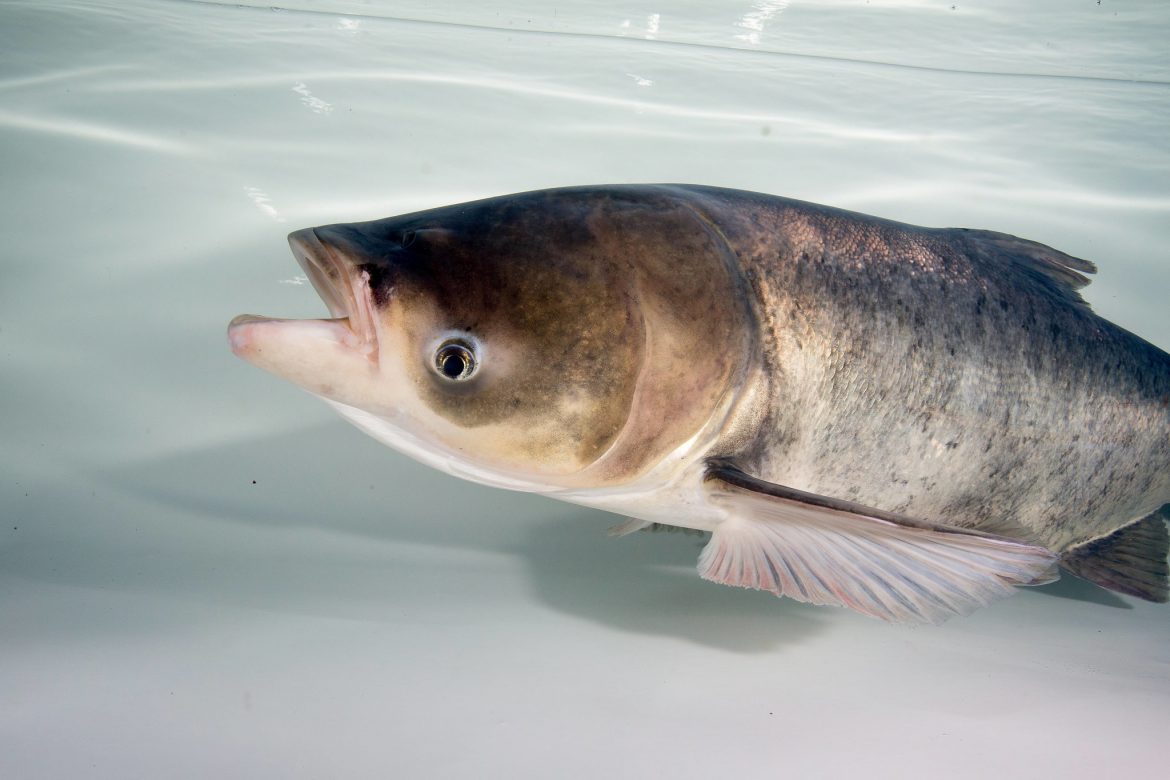By Carin Tunney
Bigheaded carp are a big threat to yellow perch, according to a new model that forecasts what would happen over the next several decades if bighead and silver carp made it into Lake Huron’s Saginaw Bay.
Researchers used computer models to simulate a one-time carp introduction. The models found under a high first-year survival scenario, it would only take about 10 carp to reproduce and eventually devastate perch populations by eating both fish and their food sources. The research is published in Biological Invasions and was done by the National Oceanic and Atmospheric Administration (NOAA), the Cooperative Institute for Great Lakes Research and other partners.
The largest concern with invasive carp is disruption of the food web. Both types of carp can grow several feet long and to about 100 pounds. The massive fish eat mostly plankton, which is a primary food source for yellow perch, a popular fish for Great Lakes anglers. Asian carp eat equal to 40% of their body weight daily.
“Once Asian carp can establish themselves and they reach a stable population size, the Asian carp feed at the base of the food chain,” said Doran Mason, a NOAA research ecologist involved in the research. “So there may be insufficient food for our native perch that feed on those.”
A second modeling scenario hinges on carp being unable to thrive in Lake Huron for reasons like water temperatures, levels or being eaten by other fish. That model suggests more than 100,000 carp would have little impact. Both scenarios describe a one-time event in which carp are introduced into the lake.
Researchers couldn’t say if the high or low survival scenario was more likely. Available nutrients and water temperatures influenced high and low-survival scenarios, Mason said. Carp become more energetic, eat more and reach reproductive size faster in warmer waters. The temperatures across the Great Lakes have increased by 1.5 to 2.2 degrees over the past 30 years, according to climatecentral.org.
Scientists said the research highlights the biggest hurdle to predict the effects of Asian carp on the Great Lakes – it’s not clear if the invasive species can survive in the large, freshwater lakes, which have different ecosystems than warmer tributaries and rivers where the carp are well-established.
Still, the models offer some helpful foresight.
“Models allow us to explore a range of scenarios,” said Lori Ivan, a postdoctoral researcher at Michigan State University and the lead author of the study. “Managers can use models like ours to guide management and policies given a range of potential outcomes.”
Mason said the modeling helps scientists evaluate “what if” questions. It uses information from the Illinois River where carp are already established to increase their confidence in the predictions.
“For the Great Lakes we are asking the question of if they were to get in, what sort of effect might they have,” he said. The Illinois River, which already has carp, offers an opportunity to let us see how well the models work.
Walleye would survive under both the high and low survival scenarios. Researchers said it’s likely walleye would shift from perch to young carp as a food source.
“Walleye in itself presents a different story,” Mason said. “Which is curious because we know both perch and walleye are very popular species in the Saginaw Bay. Walleye also eat yellow perch, so you might suspect that if yellow perch decline, we might expect walleye to decline, but we don’t see that with the models. What we see is yellow perch declining and walleye remaining pretty much unaffected.”
Mason said it’s unlikely the walleye population is large enough to control Asian carp, even if they move to the invasive fish as a food source.
The new research considered only bighead and silver carp, and studied the effects only on Lake Huron. Scientists said the chance of survival is different in each of the Great Lakes because of different food sources, water temperatures and depths. It’s difficult to make predictions because these types of carp haven’t entered a Great Lake.
Mike Weimer, a U.S. Fish and Wildlife Service fishery biologist and the co-chair of the Asian Carp Regional Coordinating Committee said studies like this help shape carp management decisions, but it’s difficult to understand the full impact of carp establishment in the Great Lakes.
“There is so much uncertainty,” he said. “These are dynamic systems; you can’t exactly say with a definitive answer what will happen. We want to err on the side of caution, and always be conservative. I go back to that prevention is the key.”
Most Asian carp management funds aim to keep carp from entering Lake Michigan, Weimer said. About $45 million a year is dedicated to carp detection, prevention, control and research. Some projects include paying commercial fishing operations to remove fish and disconnecting temporary pathways between the Great Lakes and other river basins that merge during floods. Another major project is an electric dispersal system in the Chicago Area Waterway System. It uses electric currents to deter fish from going between Lake Michigan and the Illinois waterways.
Weimer said public awareness is also part of the management effort since Asian carp look similar to baitfish and are sometimes found in bait shops, so anglers being able to identify Asian carp when they are small and full grown is important. It’s also important to not dump leftover bait in the lake.
“The proper use of bait remains an opportunity for folks to be informed and make sure that nobody’s inadvertently moving any type of aquatic invasive species for that matter, but in the worst case specific to Asian carp,” he said.
Canada also has a website with carp prevention efforts, which include removing Grass Carp from waterways connected to Lake Erie. Grass carp have been found in every Great Lake but Superior, and are most often found in Lake Erie.
